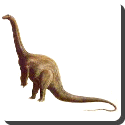 Apatosaurus — Apatosaurus popularly (though incorrectly) known as Brontosaurus, is a genus of sauropod dinosaur that lived about 140 million years ago, during the Jurassic Period. It was one of the largest land animals that ever existed, with an average length of 23 meters (75 ft) and a mass of at least 23 metric tons (25 short tons). The name Apatosaurus means ’deceptive lizard’, so-given because the chevron bones were like those of Mosasaurus.
Apatosaurus — Apatosaurus popularly (though incorrectly) known as Brontosaurus, is a genus of sauropod dinosaur that lived about 140 million years ago, during the Jurassic Period. It was one of the largest land animals that ever existed, with an average length of 23 meters (75 ft) and a mass of at least 23 metric tons (25 short tons). The name Apatosaurus means ’deceptive lizard’, so-given because the chevron bones were like those of Mosasaurus.
The cervical vertebrae were less elongated and more heavily constructed than those of Diplodocus and the bones of the leg were much stockier (despite being longer), implying a more robust animal. The tail was held above the ground during normal locomotion. Like most sauropods, Apatosaurus had only a single large claw on each forelimb, with the first three toes on the hindlimb possessing claws.
Early on, it was believed that Apatosaurus was too massive to support its own weight on dry land, so it was theorized that the sauropod must have lived partly submerged in water, perhaps in a swamp. Recent findings do not support this. In fact, like its relative Diplodocus, Apatosaurus was a grazing animal with a very long neck and a long tail that served as a counterweight. Fossilized footprints indicate that it probably lived in herds. To aid in processing food, Apatosaurus may have swallowed gizzard stones (gastroliths) in the same way that many birds do today, as its jaws lacked molars with which to chew tough plant fibers.
In 1877, Othniel Charles Marsh published notes on his discovery of Apatosaurus ajax. He followed this in 1879 with a description of another, more complete, dinosaur specimen. He speculated that the latter specimen represented a new genus and named it Brontosaurus excelsus. In 1903, it was discovered that Brontosaurus excelsus was in fact an adult Apatosaurus and the name Apatosaurus, having been published first, was deemed to have priority as the official name; Brontosaurus was relegated to being a synonym. In the 1970s, it was proven that the traditional “Brontosaurus” image known to all was, in fact, an Apatosaurus excelsus with a Camarasaurus head incorrectly placed on its body.
 Kids Portal For Parents India Kids Network
Kids Portal For Parents India Kids Network
